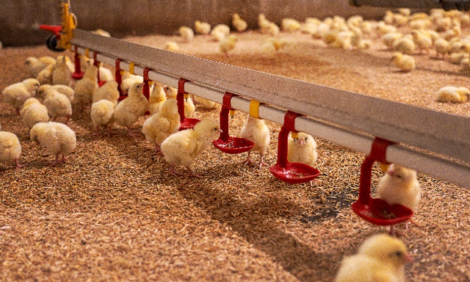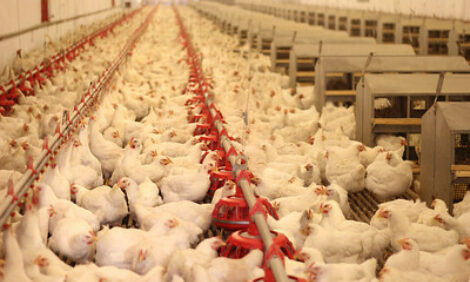



Nutrient Analysis of Poultry Litter and Possible Disposal Alternatives
By G.T. Tabler and I.L. Berry for the University of Arkansas's Avian Advice - Recent work has shown that a 40 x 400’ broiler house will produce about 105 tons of litter per year (Tabler, 2000). Since there are an estimated 13,000 broiler houses in Arkansas, this means that about 1.4 million tons of litter are generated in the state annually. Management of poultry litter has become an important issue for Arkansas farmers, the poultry industry and the general public as attention on the environment increases.Introduction
New and innovative methods of utilizing litter continue being researched, but land application of litter remains the most common use. Litter contains essential nutrients for plant growth. It also
contains organic matter that improves soil characteristics. For both of the above named reasons, there is rising interest in eastern Arkansas in using poultry litter as a soil fertilizer. Also, chicken litter is well known as a valuable fertilizer for pasture and forage production which is vital to most Arkansas cattle operations.
While the fertilizer value of litter is well recognized, the nutrient concentration of litter
can be extremely variable depending on a variety of factors. Yet without correctly sampling and analyzing litter before it is spread, there is no way to know its fertilizer value. In addition, soil testing is necessary if land application of litter is to be done accurately. Regular analysis of both litter and soil should be important parts of the Best Management Practices program on your farm.
Litter Nutrient Analysis
Litter has been shown to vary widely in its range of nutrient content (Table 1) and a number of factors can influence the nutritive value of litter. However, we have probably all wondered how nutrient concentration of litter changes with successive flocks. Figure 1 demonstrates the litter nutrient analyses of 9 flocks of 6-week birds grown on the same litter. Litter nutrients increased rapidly for three flocks, then slowed in later flocks, but continued to increase. While all nutrients increased with successive flocks, nitrogen and phosphorous assays tended to have more dramatic increases than potassium and calcium.
The data graphed in Figure 1 are shown in Table 2 along with other data. Litter pH ranged from a low of 6.9 after flock 5 to a high of 7.8 after flocks 7 and 9. Litter pH is important because greater amounts of ammonia are produced if pH is basic (greater than 7). Litter treatments that lower ammonia production do so by lowering the litter pH and making the litter more acidic (pH less than 7). Moisture content ranged from a high of 36% after flock 5 (February) to a low of 22.3% after flock 9 (August). Litter moisture was higher from October through March (colder season of the year when curtains are closed and minimum ventilation is used) than from March through August (warmer season when curtains are down or tunnel ventilation is in use). This
emphasizes the importance of adequate ventilation in keeping dry floors. Ash is a measure of the inorganic (or mineral) portion of litter. The ash content ranged from 19.6% after flock 1 to 26 % after flocks 3 and 8. These were typical ash values as chicken litter has a high ash content of roughly 25%.
Data in Table 3 show litter assay values for four years of broiler production (2 years of 8-week birds and 2 years of 6-week birds) at the Applied Broiler Research Unit. During this time, a 12-month cleanout schedule was followed each year except for 1996 when cleanout was at 16 months. The nutrient values in Table 3 are generally higher than those in Table 2, but are well within the range of values shown in Table 1. The last two columns show litter production in pounds of litter (“as-is” and dry weight) produced per pound chicken liveweight per year. These units allow the estimation of litter production regardless of house size, bird numbers or bird size. The averages of 0.55 lb wet litter, or 0.42 lb dry weight, per lb bird weight, represent the litter produced by annual cleanouts. Chicken litter is relatively lightweight, in this case weighing between 30.5 and 41.5 lbs per cubic foot (Table 3). This fact should assist in determining
transportation and handling costs.
Economics of Litter Disposal
A well-managed, 25,000-bird poultry house can annually produce 5.5 flocks of birds weighing 4.5 pounds with 94.5% usable birds that dress 75%. This is equivalent to 414,176 lbs of marketable whole-bird poultry per year (Doye et al., 1992). This house will generate about 125 tons of litter annually, or about 0.6 pounds of litter per pound of marketable meat produced.
According to Goodwin (2003), the current hauling cost for a 25 ton tractor trailer load of litter is roughly $3.00/mile. This would be $0.12/mile/ton or $0.00006/mile/lb. If each bird contributes
0.6 pounds of litter per pound of bird, then the cost of transporting litter, on a per pound of poultry produced basis is 0.6 x $0.00006/mile/lb, or $0.000036/mile. In plainer English, it would raise the production cost of poultry $0.000036/pound to transport litter associated with producing the poultry, 100 miles.
These increased costs will likely have to be passed on to consumers. It has been estimated that about fifty percent of the litter in concentrated poultry production areas of the United States is surplus (i.e. cannot be land applied in that region) (Wimberly, 2002). Thus, on average, alternatives are needed for managing approximately 50-70 tons of litter generated each year
at a typical broiler production facility located in such an area (Wimberly, 2002).
Other Options
Recent environmental concerns have focused increased attention on developing wider litter use alternatives. One alternative being examined is using litter as a fuel source for heating poultry farms. If perfected, such a use would address some of the environmental concerns associated with traditional litter management practices and reduce operating expenses (Wimberly, 2002). However, the challenges associated with making on-farm litter-to-energy systems a reality are substantial. Wimberly (2002) reported that there are numerous advantages associated with large-scale, centralized litter-toenergy options. Although centralized systems are commercially proven, to operate efficiently such systems would require the use of most, if not all the litter in a given area. Thus, centralized litter to energy systems would require the support of many if not all the area growers.
Summary
The Arkansas poultry industry generates an estimated 1.4 million tons of broiler litter annually. While litter is still a valuable fertilizer resource that is needed in many areas, litter generated in poultry-producing regions cannot be properly utilized in those regions alone. By some estimates, alternative uses for perhaps as much as half the litter generated in concentrated production areas must be found. This may mean transporting litter to areas in need of its fertilizer and organic matter, and how best to do this is currently being addressed. One alternative being examined is using litter as a fuel source. While on-farm use of litter as a fuel would address many environmental concerns associated with traditional litter management practices and reduce operating expenses, the challenges associated with making on-farm litter-to-energy systems a reality are substantial. Although there are numerous advantages associated with large-scale, centralized litter-to-energy options, to operate efficiently such systems would require the use of most, if not all the litter in a given area.

and Potassium Values for Broiler Litter1

1 Adapted from VanDevender et al., 2000.
2 Values are for 2,054 broiler litter samples analyzed by University of Arkansas Agricultural Diagnostics Lab from 1993 to 2000.
Research Unit during 9-flock growout1

1 Initial bedding material was 50/50 mix of rice hulls and pine shavings/sawdust.
2 Caked litter was removed after each flock, but samples were taken before cake removal.
3 Figures are averages of four 40 x 400' houses on the farm.
the Applied Broiler Research Unit1

1 Adapted from Berry (1997)
2 As is
References
Berry, I. L. 1997. Litter production at the Broiler Energy Project. Pages 9-10 In: Progress Report: Broiler Energy Project 1995-97. Center of Excellence for Poultry Science, Coop. Ext.
Ser., Agri. Exp. Sta., University of Arkansas, Fayetteville.
Doye, D. G., J. G. Berry, P. R. Green, and P. E. Norris. 1992. Broiler production: Considerations for potential growers. Okla. Coop. Ext. Ser. Fact Sheet 202. Oklahoma State University, Stillwater.
Goodwin, H. L. 2003. Personal communication.
Tabler, T. 2000. How much litter do broilers produce? Avian Advice 2(1):6-8.
VanDevender, K., J. Langston, and M. Daniels. 2000. Utilizing dry poultry litter – An overview. Arkansas Coop Ext. Ser. FSA8000-2.5M-12-00RV. University of Arkansas, Fayetteville.
Wimberly, J. 2002. The status of on-farm litter-to-energy systems in the United States. Proc. National Poultry Waste Management Symposium pp. 53-57.

Source: Avian Advice - Fall 2003 - Volume 5, Number 3








